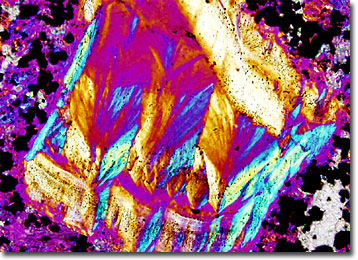Polarized Light Microscopy Digital Image Gallery
Peridotite
Peridotite is generally believed to be the most common rock found in the upper mantle of the Earth. The medium- to coarse-grained intrusive igneous material does occur in several different forms and environments, however, including layered complexes, sills, irregular masses, dikes, and volcanic pipes.

View a second image of Peridotite
When weathered, peridotite often exhibits a brownish appearance due to the formation of iron oxides, but the rock is more familiar in its fresh, green form. The typical coloration of peridotite is indicative of its mineralogical content, which is comprised of at least 10 percent of the yellowish-green mineral olivine. Peridotite also usually contains significant amounts of pyroxenes and other iron- and magnesia-rich minerals, but less than 10 percent feldspar. A variety of the rock comprised almost entirely of olivine is known as dunite.
The primary reservoir of all naturally occurring diamonds and chromium ore, peridotite is an economically important resource. The rock, which is also a frequent host of platinum metals and talc deposits, can be found worldwide, but is particularly prevalent in New Zealand and the United States, where notable occurrences exist in New York, Arkansas, Georgia, Kentucky, and the Carolinas. The location that may retain one the most valuable instances of peridotite, however, is the Kimberley district of South Africa. In this area, the peridotite, typically referred to as kimberlite, contains the only diamonds known to occur in the matrix of their original formation.
